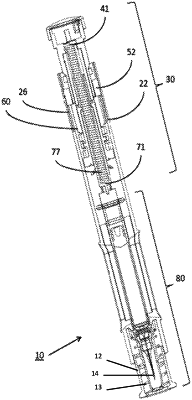| CPC A61M 5/002 (2013.01) [A61M 5/2033 (2013.01); A61M 5/24 (2013.01); A61M 2005/2073 (2013.01)] | 16 Claims |

|
1. A medicament delivery device comprising:
a housing having an open terminal distal end and an inner surface comprising a key member;
a body comprising a tubular portion and an end cap portion, where the body is configured so that it can slide axially relative to the distal end of the housing from a first axial position to a second axial position;
a drive member movable relative to the housing;
a control member rotatably positioned on the tubular portion of the body and having a first mating member;
a locking member slidably positioned on the body and having a second mating member configured to engage with the first mating member,
wherein when the body is in the first axial position, the first and second mating members
are engaged such that the control member is rotatably fixed relative to the tubular portion,
wherein the body is located radially outside the drive member and radially inside the control member,
wherein movement of the body from the first position to the second position causes the key member to engage with the locking member such that the locking member moves distally relative to the control member causing the second mating member to disengage from the first
mating member, and
wherein when the body is in the second axial position the first and second mating members are not engaged such that the control member can rotate relative to the housing and the tubular portion.
|